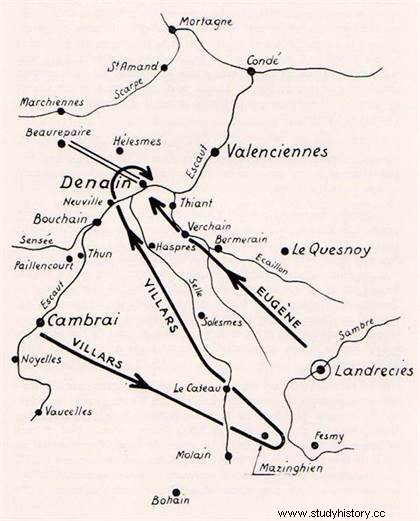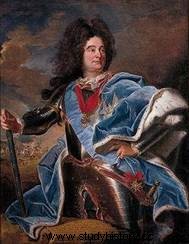 The War of the Spanish Succession has been raging since 1704, but will end with the last great French victory , July 24, 1712 during the Battle of Denain . A simple fight in four to five hours, a model of strategy admired in military schools, which had considerable results:this victory finally made it possible to sign the peace treaty of Utrecht in April 1713 and drew the northern border of France, as it is more or less now.
The War of the Spanish Succession has been raging since 1704, but will end with the last great French victory , July 24, 1712 during the Battle of Denain . A simple fight in four to five hours, a model of strategy admired in military schools, which had considerable results:this victory finally made it possible to sign the peace treaty of Utrecht in April 1713 and drew the northern border of France, as it is more or less now.
The situation before the Battle of Denain
The accession of Louis XIV's grandson Philippe d'Anjou to the Spanish throne in 1701 was the cause of the Second War of the Spanish Succession. This rise in power of France in Europe and in the Spanish colonies threatened the balance of forces established by the Peace of Ryswick (1697) and involved France in a war against the Empire and England. This War of Succession began with a series of often disastrous battles for the kingdom of France, faced with the alliance of the allies composed of England, the United Provinces, Austria, Savoy, Prussia and Saint Empire, the enemy armies being often led by two great leaders Eugene of Savoy and the Duke of Marlborough, facing Marshal de Villars.
 But for some time, England has been trying to sign a peace treaty, unable to cope with heavy financial burdens in terms of war, and above all accepts a truce with King Louis XIV:England withdraws from the fight on July 17. Prince Eugene of Savoy did not see it that way and continued to wage war, wanting to end the conflicts with a great coup in the north of France. This will be the Battle of Denain.
But for some time, England has been trying to sign a peace treaty, unable to cope with heavy financial burdens in terms of war, and above all accepts a truce with King Louis XIV:England withdraws from the fight on July 17. Prince Eugene of Savoy did not see it that way and continued to wage war, wanting to end the conflicts with a great coup in the north of France. This will be the Battle of Denain.
Having already taken Lille, Douai and Le Quesnoy, there is only one place left to take to head quietly towards Paris:Landrecies. Eugene has 130,000 well-equipped men, facing about 70,000 tired French, lacking artillery and ammunition.
The installation of the troops
On a map, let's put Marchiennes to the north, Landrecies to the south, Denain in the middle, Le Quesnoy on the right side and Valenciennes a little higher to the right. On July 17, Eugene of Savoy installed his troops between Marchiennes where his food stores were and Landrecies 60 km away, Denain being between the two where he established a garrison. It connects Marchiennes and Denain by a small road for the transport of food and ammunition which he calls “le chemin de Paris”. On each side he had ditches dug, stone parapets and palisades about eight meters high so that no one could see what was going on up close, especially not the French camp at Valenciennes, and placed the largest of his army, 30 to 40 battalions at Landrecies.
Marshal de Villars receives the order to fight. After hesitating several times on the place and the best way to attack, not being able to launch himself on Landrecies given the enemy forces, he decides for Denain. The attack will be made at dawn on July 24 in order to cut the supply link; but his troops have to swallow the 30 km distance in the middle of the night, cross a river and finally attack the camp.
The course of the Battle of Denain
On July 23, around 5 p.m., the vanguard of the troops threw bridges over the Scheldt. At the beginning of the evening, the dragoons create a diversion in front of Landrecies. During this time, we move forward quietly, having put cloth under the horses' hooves and the wheels of the teams.
 On July 24, at 5 a.m., Villars was informed that the advance was not made in the time… in addition, it is no longer certain that his troops have gone unnoticed:60,000 men on the move make noise! Marshal de Montesquiou informs him that there is no enemy movement, no patrol is in sight:so we can continue!
On July 24, at 5 a.m., Villars was informed that the advance was not made in the time… in addition, it is no longer certain that his troops have gone unnoticed:60,000 men on the move make noise! Marshal de Montesquiou informs him that there is no enemy movement, no patrol is in sight:so we can continue!
At 7 a.m., the bridges are finally installed, the vanguard crosses the river. Meanwhile, there are 20,000 Dutch in the Denain camp commanded by the Earl of Albemarle, additionally protected by 6 battalions nearby.
At 8 a.m., the French army is noticed by the enemy! 6 cannon shots are fired by the Earl of Albemarle to wake up the coalition army...but it's too late! Count de Broglie's horsemen jostle those of Count d'Albemarle who are retreating, they continue to advance on "the road to Paris" and destroy a battalion transporting food. Prince Eugene, not believing in the strength of the French, goes to eat.
 At 10 a.m., Eugene was warned of the rout of his troops; he sends the 6 relief battalions towards Denain. Villars does not understand Eugene's way of proceeding:why did he not react sooner? What trap is he setting for him? Villars then gives the order to his troops who have not crossed the river to line up to secure the rear, while Montesquiou returns to the charge, pushes Villars to advance and finally they cross the river together.
At 10 a.m., Eugene was warned of the rout of his troops; he sends the 6 relief battalions towards Denain. Villars does not understand Eugene's way of proceeding:why did he not react sooner? What trap is he setting for him? Villars then gives the order to his troops who have not crossed the river to line up to secure the rear, while Montesquiou returns to the charge, pushes Villars to advance and finally they cross the river together.
The path created by Eugene is not wide! How to advance the 30,000 men? Villars and Montesquiou on the right wing, Vieux Pont and d'Albergotti on the left wing, the Marquis de Nangis and the Duke of Montemar in the center are followed by 14 columns of soldiers, each 20 meters apart.
It's 1:30 p.m. The French advance in a compact mass, go down the ditch, go up on the other side, throw themselves on the palisades, facing the fire and the guns of the Dutch, all this in 20 minutes. The Dutch fled, the French swept everything in front of them and pursued the fugitives on the bridge of Denain...which broke under the load of the wagons and the fleeing soldiers! A large number of enemies drown in the Scheldt.
The outcome of the war
Albemarle is taken prisoner, Denain is recaptured by the French, at court with Louis XIV, it was "an overflow of joy" as Saint Simon recounts.
 It was one of the greatest French military successes and as Marshal de Villars said "it's not one of those general battles that put the kingdom in trouble”.
It was one of the greatest French military successes and as Marshal de Villars said "it's not one of those general battles that put the kingdom in trouble”.
The losses on the side of the French troops are negligible with 865 killed and 1075 wounded; the enemy must support approximately 2,500 drowned, 2,500 killed or wounded, 3,000 prisoners and 10 to 15,000 men unable to fight.
The enemy's morale is damaged:communication between Eugene and the Marchiennes food stores is broken! Without food, it is impossible to continue waging war. Eugène must lift the siege of Landrecies.
Villars took the opportunity to retake Marchiennes on July 31, Douai on September 8, and Le Quesnoy on October 4, thus restoring glory to France. The peace treaty of Utrecht, signed in April 1713, allows France, despite some concessions, to keep the main territories acquired under the reign of Louis XIV and to perpetuate the Bourbons on the throne of Spain. An outcome which would not have been so favorable without Denain's victory.
To go further
- Gérard Lesage “Denain (1712), Louis XIV saves his day”. Economica, 1992.
- Wars &History Magazine n°9, October 2012.
